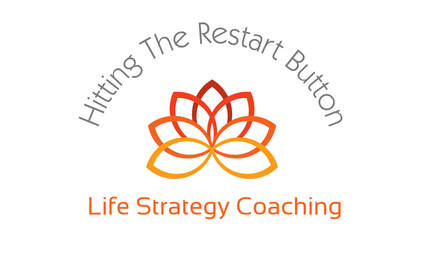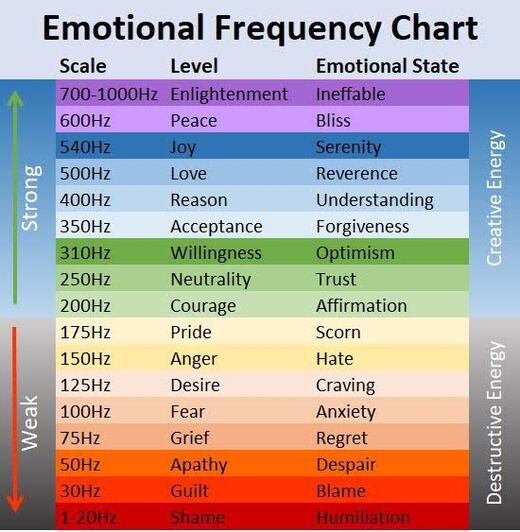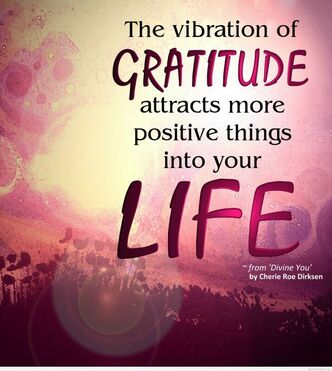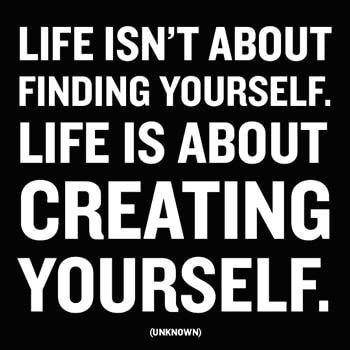|
Living in gratitude is far from a new concept and you would be hard pressed to find someone in this day and age who has not heard someone in their life's path tell them to "be grateful." What is not as mainstream a known concept is the correlation between gratitude and creating a state of high vibration in your life. As energy, light beings, we vibrate, as does everything else in the universe. The speed at which we vibrate can be measured as a frequency in the measurement of hertz (Hz). This frequency is produced by our thoughts, emotions and actions. According to Shawna Freshwater, PhD, "The higher the vibrational frequency, then the higher the expansion, and the greater the Life Force in your cells. The lower the vibrational frequency, then the greater the contraction, and the lesser of Life Force in your cells." Accordingly, the Emotional Frequency Chart below shows the Frequency Scale (measured in Hz) and the corresponding Levels of Existence, and Emotional States. You will notice that the higher the frequency, the Level and Emotional States are what we, as humans classify as "positive" states of being. Vibrating high results in feeling lighter, more at ease, both physically and emotionally. Given a choice, most people would more often opt to spend the majority of their time in peace, love, bliss and serenity, since these not only feel good, but are also the states where high levels of creative energy is experienced. So, how does gratitude affect our frequency? Well, in a word, positively!
The vibrational frequency of gratitude is 540, which is the same as joy, making it quite expansive and one of the highest vibrational frequencies you can be at. The more time you can spend in gratitude, the more your body's frequency raises and the healthier your body becomes. Gratitude is beyond question the most powerful emotion to measure a vibrational shift. Take for instance the fact, that generally speaking, as humans, we normally give thanks or are in a state of gratitude when we receive something from an outside source. But, consider the fact that if we feel gratitude by choice, something very cool happens. Your body shifts into reception mode as the emotional signature of gratitude is positive. This is what makes gratitude so powerful. Ways of manifesting or "choosing to be in" a state of gratitude include directing your thoughts and actions towards that end. Helping others, doing random acts of kindness and thanking those that we encounter throughout our day raise our emotional vibration. More subtle ways of practicing gratitude have to do with our mindset and attitude, which, over time will take the place of lower vibrational ways of thinking. This includes noticing good things and purposefully seeking them out, appreciating and savoring them. In general, just paying attention to the bright and favorable stuff in our midst. One of the best ways to solidify this practice is to express your gratitude to yourself, saying thanks to others, or writing it down in a gratitude journal. Gratitude can also help relieve the psychological and physiological effects of stress. Through these simple actions, you will be activating the brain chemicals that make you happy, thereby decreasing negative emotions, increasing empathy, and creating a much improved outlook. The result often includes higher self-esteem, more inner strength, better heart health and even better sleep. As you get in the habit of directing your mindset towards gratitude, it will become as natural as breathing. You will literally feel the shift in your being as you begin to resonate more in a high vibrational state. The result includes attracting the most wonderful opportunities, outcomes and the manifestation of your dreams. Love & Light, Elisa
0 Comments
I think we would all agree that it is never easy to make a change, any change, in life. When contemplating divorce, the stakes are raised significantly higher since this experience is a life transition that brings with it a plethora of changes that can spark tremendous fears. For homemakers, in particular, fear is often the overriding factor that can shake one's confidence and sense of well being. While fears can be numerous and differ based on individual circumstances, here are four common ones along with suggestions for feeling more empowered. 1. Economic Fear For many homemakers, one of the greatest worries is financial. The most common questions being, will I have enough money to take care of myself and my children? This is a very realistic concern. If you've been a stay-at-home mom, which is a common decision made by numerous women once they have children, then your job has been the raising of children and managing of a home, versus being a part of the work force. Many women opt to give up careers in order to become full-time moms. The good news is that you have opted to put one hundred percent into raising your kids. The challenging news is that your partner is the one who is making the money. Here are a few things for you to know as well as a few steps to take that can set you on the right path to strengthen your position for independence. First, depending on which state you live in, there are laws that protect the "un-monied" spouse (the one that has not worked and has stayed home to raise children) in the form of spousal support and child support. Generally, there are formulas used to estimate how much you should be paid and for what length of time. In general, spousal support is based on the length of the marriage, the level at which you have been accustomed to living as well as other factors. Child support is based on formulas that have to do with the number of children, who has custodial custody and other specific factors. Again, these are generalities that can differ by state. Your attorney can give you more factual information. 2. Getting Back into the Workforce Financial circumstances will almost always be affected after divorce. With the economy being what it is, it's hard enough for a family to make ends meet with one residence and one income provider. After divorce, most couples will find themselves living in two domiciles with twice the home expenses, such as housing, separate insurance costs, vehicle, household expenses, etc. One of the most common fears I hear expressed by homemakers getting divorced is "how do I get back into the workforce?" It can be very daunting contemplating the idea of going back to work after years of being home. The two overriding factors that cause anxiety for full-time homemakers include not being a full-time stay at home mom for the kids, and being uncertain about qualifications in a changed job market. While the solutions are multifaceted, I would like to suggest that it all begins with taking a deep breath and realizing that such a change is a slow process. A good first step is to start off small. If you haven't worked in a while, or are unsure where to begin, start with a part time job, either in the area that you may already have experience or in a new area. Don't focus on the pay or even the position itself. This is just a way to get your feet wet and start the process, Believe it or not, this will build confidence while getting you acclimated to a new "out of the home" routine and having your own money. 3. Juggling Motherhood and Work Feeling overwhelmed is one of the most common issues expressed by many divorced moms. Whether it's balancing being there for kids with a work schedule or managing the pressures of an apartment or house, divorced moms often feel like they are constantly being pulled in a variety of directions. While I wish I could tell you that you shouldn't feel overwhelmed, I think the more important advice to be given here is that there are ways to manage this very real feeling. In most cases, there just doesn't seem to be enough "me" to go around or enough time to get everything done. However, I assure you, there are plenty of small moments to stop, and decompress. Just taking five to ten minutes throughout the day to breathe intentionally can do wonders. Did you know that deep breathing can reset the brain? Calm deliberate breathing can send a message to the brain that you are calm, even if you are feeling stressed, and in turn, allow your body and mind to actually relax. A frenetic, worried state only prolongs feeling overwhelmed, so incorporating relaxation techniques can reset yourself and take the focus off of the many "to do's" you may have. A great go-to breathing technique is the 5-5-7 breath. Breathe in for a count of five; hold the breath for five and then breathe out powerfully to a count of seven. Do this five or six times whenever you feel the weight of the world. Another great way to calm yourself is a technique called havening. According to Dr. Steven Ruden and Dr. Ronald Ruden, the creators of the technique, the use of therapeutic touch can help treat mental health symptoms by changing pathways in the brain linked to emotion. Havening is a way to self-soothe. With crossed arms, gently but noticeably stroking from shoulders to elbows. You can also rub the palms of your hands together in a circular motion, This is all to create a sense of wellbeing and safety, which can lessen feelings of overwhelm. 4. Being Alone Then there is of course, the overarching fear caused by the idea of being alone or without companionship...ever! Divorce takes you from a state of having a partner to not. For many, this can cause feelings of loneliness and the belief that you will always be alone. This can be very frightening and even exacerbated if your soon-to-be or former spouse is already in another relationship. Finding companionship with a new person and rebuilding the romantic part of one's life is all part of the healing process. One of the first steps to healing and building a new life is to reconnect with yourself. Learning how to be kind to yourself, love yourself and appreciate the wonders of who you you are will build your confidence and attract people to you that will enhance and fill your life. There is life after divorce in spite of the fears felt leading up to and through the process. Facing one scary issue at a time with self love and patience will enable you to reset, restart and rebuild. Love & Light, Elisa One of the hardest aspects of divorce to come to terms with is the change in one's identity. Whether you are a man or woman, part of the transition from a married person to a divorced person involves the change in your "status." This can bring with it a myriad of feelings, one of which includes a sense of insecurity about who you are. For most, marital status becomes a huge part of self identity and how we define ourselves in the world. It is not merely a title or a box to check on credit card applications and other documents, it's the way in which we fit into society as a whole, our families and social circles. Being part of a married couple weaves itself into the fabric of our existence, providing a context within which to view ourselves and how we fit into the world at large. As an individual, self-identity becomes synonymous with our marital status. Daily life routines and responsibilities are often carved out, divvied up and shared as part of a twosome. How, when, and why we engage in many of life's activities will often be based on or because of this prominent relationship. Is it any wonder that the break up of a marriage can cause tremendous uncertainty about one's identity - who you are, how you fit in, what your role is, your purpose? Add to this the fact that as human beings, we are not built for change. Our brains are wired to keep us safe by thinking and doing the same things over and over. So, adapting to a new way life, redefining who you are and reframing the way in which you live in this new reality is not something that happens overnight. The changes that are thrust upon us during and post divorce are immense. Many of us have no idea what the implications will be as we begin this journey, subsequently feeling blindsided when the old "definition" of who we are no longer fits.
Take a deep breath. Remember that with each day, and the new experiences you have as a single person, deconstructing your previous life as a couple, is slowly creating and defining your new identity. This does not happen overnight but does evolve inevitably over time. Much like the compound effect, which states that with consistent effort each day, change becomes visible over time, so too will the "change" in you become visibly clear and reveal an entirely different you with each passing day, week. and month. Your new identity, who you are and what your purpose is will take shape and become the norm. Weathering through the storm of discomfort of "who am I" is not easy, but do so remembering that even the caterpillar requires time to transform into the beautiful, soaring butterfly. Love & Light, Elisa |
ELISA
|
|
Elisa Valentino
HOLISTIC BEHAVIORAL PRACTITIONER DIVORCE & LIFE TRANSITION COACH SPIRITUAL LIGHTWORKER PUBLIC SPEAKER PODCAST HOST |
©2024 Hitting The Restart Button







 RSS Feed
RSS Feed
